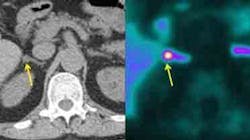Imaging system can help pinpoint blood pressure problem
A tomography scan-based test developed by researchers at the University of Cambridge (Cambridge, UK) could help doctors diagnose thousands of people with hypertension -- the most common curable cause of high blood pressure.
Around 12 million people in the UK are diagnosed with hypertension, a condition that greatly increases the risk of having a heart attack or stroke. For most people, there is no single underlying cause, but in a small minority, a specific condition called Conn’s syndrome causes blood pressure to rise.
Conn’s syndrome is caused by a benign tumor called an adenoma in one of the adrenal glands, which lie close to the kidneys. The tumor causes the over-production of a key blood pressure-regulating hormone called aldosterone. It can be treated either by surgically removing an affected gland, or by using a drug to block the effects of aldosterone.
To detect the presence of such a tumor, the Cambridge researchers developed a special radioactive tracer called 11C-metomidate that lights up culprit adenomas during a PET-CT scan in a test that takes around 45 minutes.
The current standard test for Conn’s syndrome relies on taking blood samples from a vein supplying the adrenal gland to measure the aldosterone level, a complex and difficult procedure which often fails to confirm the diagnosis. However, the researchers showed that their scan picked up adenomas causing hypertension in the majority of patients they studied, making it a potentially useful alternative to the standard test.
More information can be found on the university's web site.
-- By Dave Wilson, Senior Editor, Vision Systems Design
